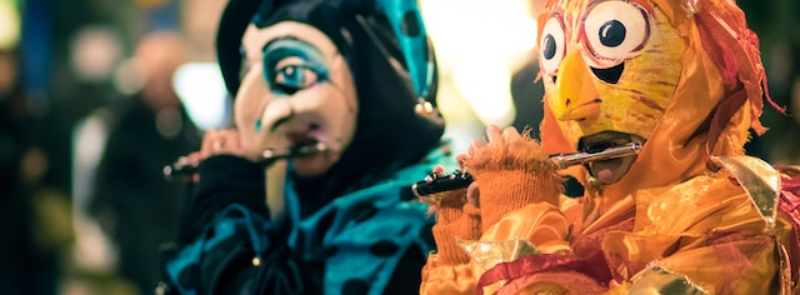
When It Occurs
Every Second Saturday in October
Official Website
Timeline
Days Passed (807)
# Hashtags
#NationalCostumeSwapDay #Fashion
National Costume Swap Day occurs every second Saturday in October, specifically on October 12, providing an opportunity to bring your beloved characters to life. Costumes have served as cultural representations for various regions across many years. The term "costume" historically referred to the appropriate attire for specific activities, like swimming costume, riding costume, and evening costume.
History of National Costume Swap Day
- Origins: National Costume Swap Day was initiated by Green Halloween®, a grassroots movement founded by environmentalist Corey Colwell-Lipson in 2007. The movement aimed to make Halloween more sustainable and less wasteful. The first official National Costume Swap Day took place in 2010.
- Purpose: The day’s primary goal is to encourage the reuse of costumes, reduce consumerism, and promote eco-friendly practices. It’s also a fun way to engage communities and share resources.
Significance of National Costume Swap Day
- Environmental Impact: By swapping costumes, families can reduce the demand for new costumes, which often contain non-recyclable materials. This practice helps lower the environmental footprint associated with manufacturing and disposing of costumes.
- Cost Savings: Costume swaps are a cost-effective way for families to obtain new-to-them costumes without spending money. This can be especially beneficial for families with children who may only wear a costume once.
- Community Building: Costume swaps foster a sense of community by bringing people together to share resources. It’s a fun and interactive way for neighbors and friends to connect.
How to Celebrate National Costume Swap Day
-
Organize a Costume Swap:
- Community Event: Organize a community costume swap event at a local community center, school, or park. Encourage participants to bring their gently used costumes and exchange them for new ones.
- School Swaps: Schools can host costume swaps for students and parents. This can be a great way for families to find costumes for their children and encourage a culture of sharing and sustainability.
-
Host a Swap Party:
- Invite Friends and Family: Host a costume swap party at your home. Invite friends, family, and neighbors to bring costumes they no longer need and swap them for different ones. Provide snacks and make it a festive occasion.
- Themed Swaps: Make the swap party themed, such as a superhero costume swap or a historical figure costume swap, to add an extra layer of fun and excitement.
-
Participate in Online Swaps:
- Social Media Groups: Join local social media groups or community boards dedicated to costume swaps. These platforms can be a great way to connect with others looking to swap costumes.
- Online Marketplaces: Use online marketplaces and apps that facilitate swapping or reselling items. Websites like Freecycle and local Buy Nothing groups can be excellent resources.
-
DIY Costume Workshops:
- Creative Reuse: Host a DIY costume workshop where participants can learn how to repurpose and customize existing costumes. Provide materials like fabric, paint, and accessories to help them get creative.
- Upcycling: Teach techniques for upcycling old costumes into new ones. This can include altering sizes, adding new elements, or combining parts from different costumes.
-
Spread the Word:
- Social Media: Use social media to spread the word about National Costume Swap Day. Share tips, ideas, and photos using hashtags like #CostumeSwapDay and #GreenHalloween.
- Flyers and Posters: Create and distribute flyers or posters in your community to promote local costume swap events. Schools, libraries, and community centers are great places to display these.
Benefits of Costume Swaps
-
Environmental Benefits:
- Waste Reduction: Swapping costumes reduces the amount of waste generated by disposing of old costumes and decreases the need for new materials to produce new costumes.
- Resource Conservation: By reusing costumes, fewer resources are consumed in the production, packaging, and transportation of new costumes.
-
Economic Benefits:
- Cost Savings: Families save money by swapping instead of buying new costumes, which can be particularly helpful for families with multiple children.
- Affordable Options: Costume swaps provide an affordable way for everyone to enjoy Halloween, regardless of their financial situation.
-
Social Benefits:
- Community Engagement: Costume swaps bring people together, fostering a sense of community and shared responsibility for the environment.
- Creativity and Fun: Swapping and creating new costumes can be a fun and creative activity for families and friends.
Inspirational Quotes About Sustainability and Community
- “The greatest threat to our planet is the belief that someone else will save it.” – Robert Swan
- “Sustainability is about ecology, economy, and equity.” – Ralph Bicknese
- “Alone we can do so little; together we can do so much.” – Helen Keller
Conclusion
National Costume Swap Day is a wonderful opportunity to promote sustainability, save money, and build community connections. By organizing and participating in costume swaps, hosting DIY workshops, and spreading awareness, you can make a positive impact on the environment and enjoy a fun, festive, and eco-friendly Halloween. Celebrate National Costume Swap Day by embracing the spirit of sharing, creativity, and community, and contribute to a greener future for everyone.


